eMTB vs MTB calories burned - my experience
Discussion
In February this year, I purchased an eMTB to help me get fit again for my 50th birthday and learn how to ride off-road and I believe it does both these things superbly.
In the first instance, it definitely burns calories given that you need to provide your own power to turn the pedals and that the motor assist can be adjusted depending upon what type of ride you want. In the second, I find eMTB's easier to ride over technical terrain and there is no doubt, in learning the lines and power needed for different types of terrain, it has made my riding skills on a regular MTB far better.
Owning both and riding them more or less equally now, I'd say my preferred bike is my MTB since I enjoy it more overall for the preciseness, the weight, the nimbleness and higher speed for sprinting, flat and downhill terrain but I do still like to use my eMTB for the fun it brings to the ride - specifically on more demanding climber's XC rides like my daily route described here.
Anyway, lately I've been using the same 51km all off-road route for my eMTB rides and comparing different power modes and then today, due to my eMTB needing a new chain, I did the same route on my MTB. The results are, to me, interesting so thought I'd share for anyone wondering if an eMTB will suit them for getting fit, losing weight etc.
The Route: All off-road, loose over hard terrain, 946m (3103ft) climbing, 51km (32 miles) with some challenging parts. It is three quarters of an annual Pro-Am MTB race route.
The Bikes: KTM Macina Kapoho 2972 (dual suspension and Bosch CX motor) weighing approx. 24kg and a KTM Scarp Sonic (dual suspension) weighing approx. 9.4kg.
Effort: Medium. Not gut-busting in any case. Regular 'maintenance mode' ride - mainly because I am recovering from a cold I picked up a few days ago.
Recording Equipment: Garmin Fenix 5 Plus watch and Garmin Edge 530 computer.
Results:
eMTB in 'eMTB Mode' for the whole ride = 886 calories burned. Time was 2hrs 30min.
eMTB in 'ECO Mode' for the whole ride = 1149 calories burned. Time was 2hrs 49min.
MTB = 1477 calories burned. Time was 3hrs 23min.
In all instances, I burned calories and got a work-out. The ebike is noticeably easier in its eMTB setting and the MTB provided the best work-out overall as expected. However, the difference between the eMTB in its least assist level and the MTB is not huge, albeit still significant.
The next test I'll do will be hard rides on each to see how they compare. My experience suggests that the more effort you put into the ebike, the closer the gap between eMTB and MTB in terms of calories burned and work-out intensity so I'm interested to see how they compare in 'hard ride' equivalent conditions.
Certainly, the results for this type of 'medium' intensity effort confirms my view that eMTB's can get you fitter and are not only for 'easy' rides. My regular MTB Strava times are up, for example I'm 4th fastest overall on a short hill sprint near me and 1st in my age group. Mostly down to riding an eMTB for my daily work-out.
(Whilst all my rides are now uploaded to Strava, the eMTB rides are not interfering with segments at all and are properly recorded as e-rides).
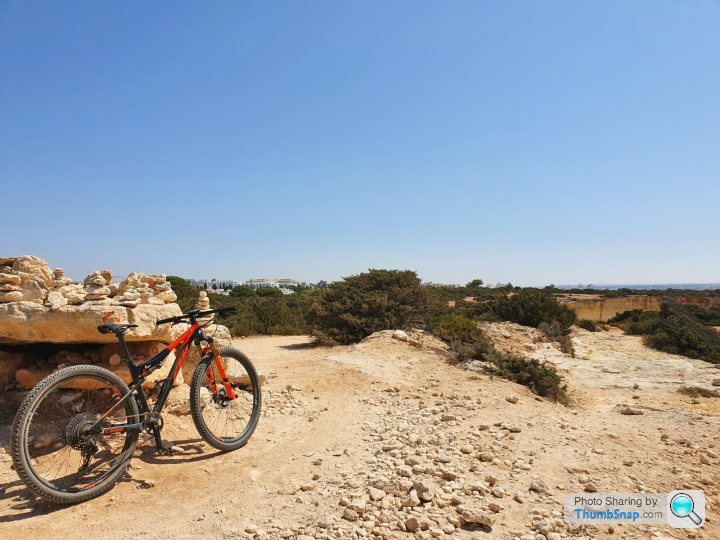
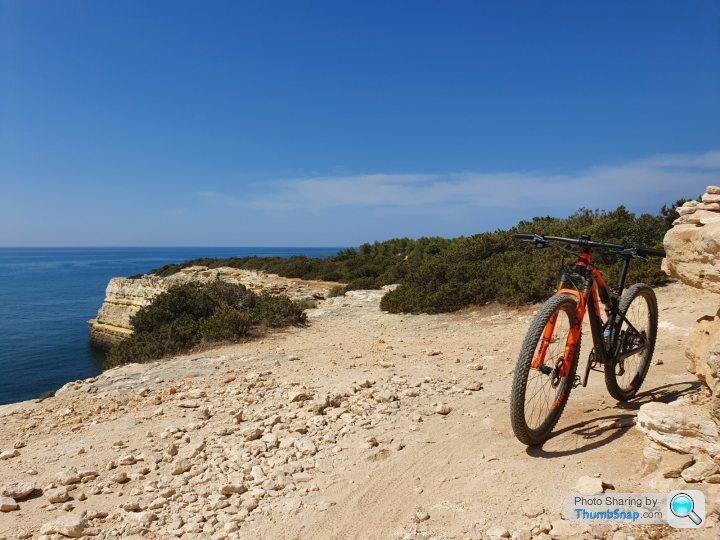
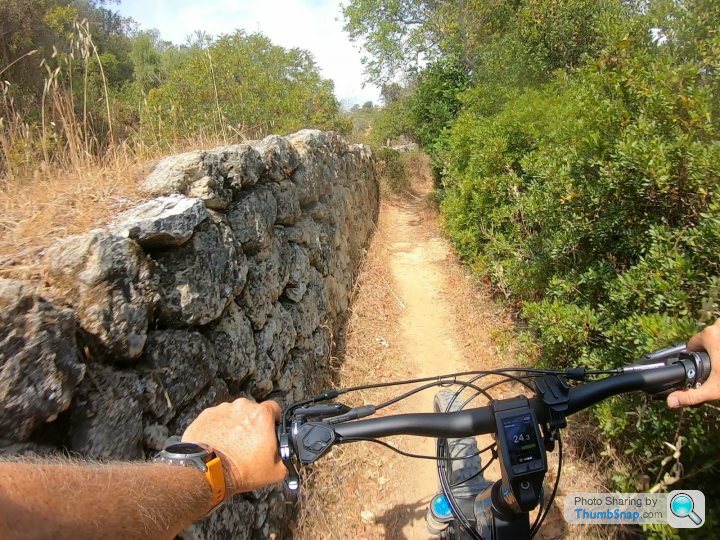
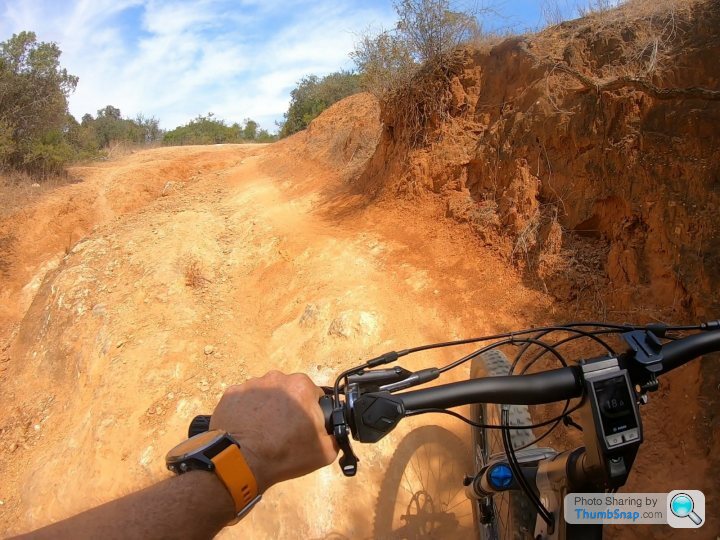
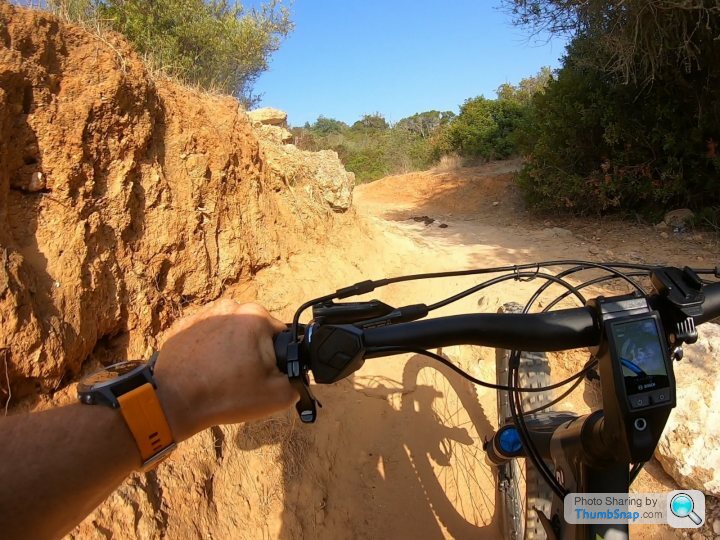
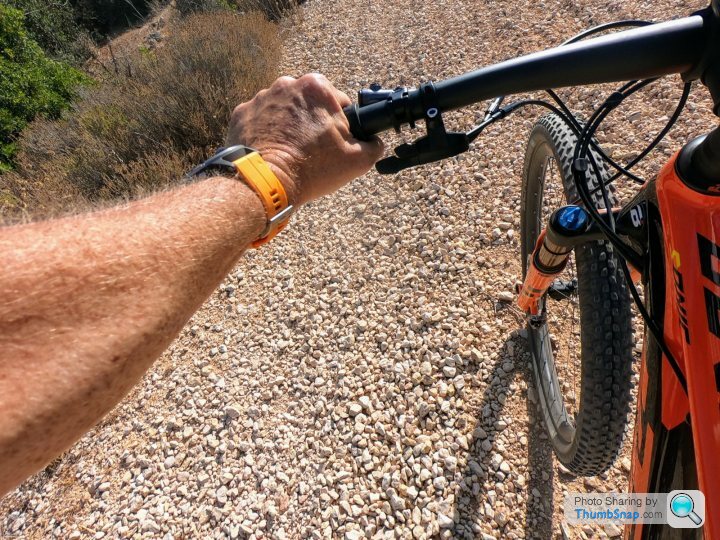
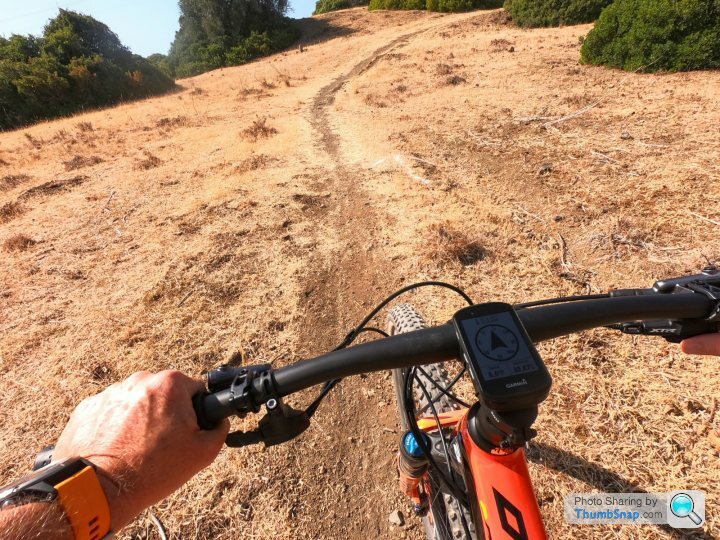
In the first instance, it definitely burns calories given that you need to provide your own power to turn the pedals and that the motor assist can be adjusted depending upon what type of ride you want. In the second, I find eMTB's easier to ride over technical terrain and there is no doubt, in learning the lines and power needed for different types of terrain, it has made my riding skills on a regular MTB far better.
Owning both and riding them more or less equally now, I'd say my preferred bike is my MTB since I enjoy it more overall for the preciseness, the weight, the nimbleness and higher speed for sprinting, flat and downhill terrain but I do still like to use my eMTB for the fun it brings to the ride - specifically on more demanding climber's XC rides like my daily route described here.
Anyway, lately I've been using the same 51km all off-road route for my eMTB rides and comparing different power modes and then today, due to my eMTB needing a new chain, I did the same route on my MTB. The results are, to me, interesting so thought I'd share for anyone wondering if an eMTB will suit them for getting fit, losing weight etc.
The Route: All off-road, loose over hard terrain, 946m (3103ft) climbing, 51km (32 miles) with some challenging parts. It is three quarters of an annual Pro-Am MTB race route.
The Bikes: KTM Macina Kapoho 2972 (dual suspension and Bosch CX motor) weighing approx. 24kg and a KTM Scarp Sonic (dual suspension) weighing approx. 9.4kg.
Effort: Medium. Not gut-busting in any case. Regular 'maintenance mode' ride - mainly because I am recovering from a cold I picked up a few days ago.
Recording Equipment: Garmin Fenix 5 Plus watch and Garmin Edge 530 computer.
Results:
eMTB in 'eMTB Mode' for the whole ride = 886 calories burned. Time was 2hrs 30min.
eMTB in 'ECO Mode' for the whole ride = 1149 calories burned. Time was 2hrs 49min.
MTB = 1477 calories burned. Time was 3hrs 23min.
In all instances, I burned calories and got a work-out. The ebike is noticeably easier in its eMTB setting and the MTB provided the best work-out overall as expected. However, the difference between the eMTB in its least assist level and the MTB is not huge, albeit still significant.
The next test I'll do will be hard rides on each to see how they compare. My experience suggests that the more effort you put into the ebike, the closer the gap between eMTB and MTB in terms of calories burned and work-out intensity so I'm interested to see how they compare in 'hard ride' equivalent conditions.
Certainly, the results for this type of 'medium' intensity effort confirms my view that eMTB's can get you fitter and are not only for 'easy' rides. My regular MTB Strava times are up, for example I'm 4th fastest overall on a short hill sprint near me and 1st in my age group. Mostly down to riding an eMTB for my daily work-out.
(Whilst all my rides are now uploaded to Strava, the eMTB rides are not interfering with segments at all and are properly recorded as e-rides).







BenjiS said:
Just out of curiosity, was your calorie burn measured by heart rate monitor (in the Fenix) or by speed/distance (in the 530)? What was your average heart rate for each ride?
Ok, so Fenix is where all the Stats go to Strava - I only use the 530 as a screen extension - so HRM for all rides. MTB ride = Avg HR of 127 bpm
eMTB ride 'ECO' = Avg HR of 126 bpm
eMTB ride in 'eMTB = Avg HR of 118bpm
I appreciate my stats are subject to Garmin's accuracy and that the HRM was on my wrist as opposed to a dedicated chest monitor but I am happy with 'ballpark figures' for my Training Effort as I can still see where the differences are and relative margins.
Can you see how much battery you used on each ride - that would give you a rough guesstimate at how many calories is you and how many is the bike - obviously different bikes will need different effort - for a direct comparison - ride your eMTB with and without assistance, look at the energy used in the battery vs the calories your HRM says each time and you should see roughly the same total (ignoring losses etc.) - this of course needs you to ride a heavy eMTB with no assist, but its for SCIENCE!
I haven't ever met a Garmin/HRM monitor that has been that accurate on calories burned (comparing it to a power meter, which can get very close)
Obviously you still need to work on a electric bike but with my only experience being the Uber JUMP bikes, I don't have much to offer - all i can say is that going uphill at 25kph took next to no effort (id guess ~50W from me) when I know my top of the range road bike would take ~200W from me to achieve the same.
I haven't ever met a Garmin/HRM monitor that has been that accurate on calories burned (comparing it to a power meter, which can get very close)
Obviously you still need to work on a electric bike but with my only experience being the Uber JUMP bikes, I don't have much to offer - all i can say is that going uphill at 25kph took next to no effort (id guess ~50W from me) when I know my top of the range road bike would take ~200W from me to achieve the same.
The pictures look fantastic! Not sure you can draw any conclusions from the figures though, as others have pointed out the calories burned thing isn't very accurate, and longer rides will cause more calorie consumption, regardless of assistance or not.
Like with the Strava suffer score, it's weighted to time in the saddle so much, you can go and do a gentle 2 hour ride and get a bigger score than if you go ballistic for 40 minutes.
Like with the Strava suffer score, it's weighted to time in the saddle so much, you can go and do a gentle 2 hour ride and get a bigger score than if you go ballistic for 40 minutes.
Daveyraveygravey said:
The pictures look fantastic! Not sure you can draw any conclusions from the figures though, as others have pointed out the calories burned thing isn't very accurate, and longer rides will cause more calorie consumption, regardless of assistance or not.
Like with the Strava suffer score, it's weighted to time in the saddle so much, you can go and do a gentle 2 hour ride and get a bigger score than if you go ballistic for 40 minutes.
I certainly agree with you and you are correct about time in saddle vs effort etc - it is hard to form an exact comparison, for sure, but the calories burned does tell a story I think. I can tell you that I rode 39km on my MTB yesterday to reach the 1149 calories burned on the same route and so match what I burned on the eMTB over the 51km total. I reached the same calorie burn 12km sooner. But perhaps I need to make notes of time too at these stages - so I will. Like with the Strava suffer score, it's weighted to time in the saddle so much, you can go and do a gentle 2 hour ride and get a bigger score than if you go ballistic for 40 minutes.

The assist does not negate calorie burn of course - it isn't using 'your calories' as someone seems to be alluding to. You can't attribute some of the calories I burned on those rides to the eMTB and reduce them accordingly - they are what they are. No different to anyone comparing calories burned on a Penny Farthing, BMX, walking, swimming or running - or calories burned driving an F1 car. Indeed, F1 racers burn circa 1400 calories per race, are we suggesting that figure should be reduced because some belong to the car? No, of course not.
So what I take from my comparisons is that eMTB's do provide a significant workout but that is a given albeit there are some folks who haven't ridden ebikes for long enough or hard enough to appreciate that yet and so still think otherwise. They can be easy, but also hard to ride, depending upon what effort you put into them and the course you choose. I know when I return from a hard eMTB ride I feel very similar to that of a decent MTB ride. This isn't debatable, it is a fact. The question I'm trying to answer for myself - and I have shared what I'm seeing so far in case anyone else is interested - is just how close can an eMTB workout get to an MTB workout.
The bikes are very different - including set up.
The eMTB is 24kg, 160mm front suspension set to very soft and I run it on very soft tyres.
The MTB is 9.4kg, 100mm front suspension set to medium and harder tyres - very much an XC racing set up.
It isn't usual that I ride the bikes over the same course - one is better than the other over more slippery terrain and that's deliberate. The other is a speed machine over less technical courses. (For me)
Riding the eMTB with the assist off for much of this particular route, is a non-starter - with my set up, it isn't very ridable at all uphill. The 'ECO' mode does give a distinct advantage, but some of that is used just to bring that bike to level terms with the XC bike in weight and set up terms.
Many studies that have been carried out to date - you can Google them but for example https://dirtmountainbike.com/bike-reviews/e-bikes/... and then this one https://electricbikeblog.com/many-calories-can-bur... where the chap did an hour as opposed to a set route like I did and showed that an eBike is around 20% less calories burned per hour. I think Livestrong have done a study too.
I'm trying to see if what these previous studies have found is true in my experience too or somewhat different since I think my eMTB set up in ECO can get closer than 80% of what I can do on my MTB although, with the rides I have to compare with to date, I am pretty much at that 80% figure so it may indeed be what the difference is: ebikes give you up to an 80% workout vs normal bikes.
Now, I can also add that prior to my getting my new MTB many of my eMTB rides were done using the Power Assist Off on the flats and downhill. I haven't added those results to my comparison since I was unable to record them with a HRM until recently - only got my watch this month.
 So I will have to do one of those rides to see if it closes the gap further too - I suspect it must, given no assist at all for part of the route.
So I will have to do one of those rides to see if it closes the gap further too - I suspect it must, given no assist at all for part of the route. Just to add - I'm not trying to suggest eMTB's are 'better' than MTB's or vice versa. Both have their place for many reasons.
Personally, I love my MTB and prefer it overall, no question. I would not ride an eMTB only. For me, the eMTB has served me well and will continue to do so as my go-to bike for my recovery rides and technically harder rides where I find mastering certain challenging areas on it first, before my MTB, is an easier path.
But it has got me reasonably fit again and got me into XC MTB'ing to boot. So I was curious to see just how close it was, that's all.
I've still some way to go before entering races again (my last road race was some 24 years ago), I've targeted a race in June 2020 and while I will be physically ready for it sooner - in terms of going for a Top 5 in my age group judging by this years results and the riders who I am already outsprinting on Strava - my technical skillage is still very much on a steep learning curve.
Personally, I love my MTB and prefer it overall, no question. I would not ride an eMTB only. For me, the eMTB has served me well and will continue to do so as my go-to bike for my recovery rides and technically harder rides where I find mastering certain challenging areas on it first, before my MTB, is an easier path.
But it has got me reasonably fit again and got me into XC MTB'ing to boot. So I was curious to see just how close it was, that's all.

I've still some way to go before entering races again (my last road race was some 24 years ago), I've targeted a race in June 2020 and while I will be physically ready for it sooner - in terms of going for a Top 5 in my age group judging by this years results and the riders who I am already outsprinting on Strava - my technical skillage is still very much on a steep learning curve.
Coolbanana said:
The assist does not negate calorie burn of course - it isn't using 'your calories' as someone seems to be alluding to. You can't attribute some of the calories I burned on those rides to the eMTB and reduce them accordingly - they are what they are. No different to anyone comparing calories burned on a Penny Farthing, BMX, walking, swimming or running - or calories burned driving an F1 car. Indeed, F1 racers burn circa 1400 calories per race, are we suggesting that figure should be reduced because some belong to the car? No, of course not.
I was just pointing out that in the interests of your experiment, riding the same ride twice (on the same bike) with varying levels of assistance and then comparing the battery drain to the calorie difference from your Garmin would be an interesting comparison - I apologise if you take it as an attack on ebikes - I really don't give two figs about them - I'm a roadie and so e-bikes are of limited interest - As I said, the only one I have ridden is an Uber JUMP in flip flops on holiday. I googled it while I was away and they apparently give a 250W boost - my Mrs was entirely unimpressed that my 290W FTP (max 1 hour power) was not much more than a tourist on a bike with a basket on the front. To expand a little more, a calorie is just a unit of energy. A watt is a unit of power and is just energy output over time. This is why I (and another poster above) mentioned power meters being the closest to actually measuring your calorie burn - there are no external factors in play - the power meter knows exactly how much power you have been putting out and for how long you have been doing it - wash that through a clever algorithm for efficiency and viola - calorie count.
If you ride your eMTB with and without assistance over the same course, in the same time then the energy used by the motor (multiplied by whatever efficiency the motor has) is energy you aren't burning yourself.
To break it down further - to move at a given speed on a bike, you need to be putting out a certain power - again, power is just energy over time - if 100W of it is you and you have 100W assist then half of the energy (which is what your calorie count is) is you and half is the bike. None of this takes into account efficiencies in the bike, motor and your human physiology of course, but I would be curious to see the results. You will also be burning calories chucking the bike around, which for the same bike, should be similar.
Obviously different bikes will result in different calories burnt - again, the best way to compare directly is power - someone putting out 250W on a penny farthing for 1 hour will burn exactly the same calories as someone putting out 250W on a eMTB/road bike/turbo trainer, but they will all go different distances.
For your F1 example, things are a bit different as the calories burned by the driver has no real bearing on how the car goes - its more akin to the IC engine (you) using less fuel (calories) because of the KERS (eMTB motor) helping out.
As I said, I have no skin in the game when it comes to ebikes - they look good fun, get people out and undoubtedly do give you a workout, if you are happy with it then that's great.
Parsnip said:
I was just pointing out that in the interests of your experiment, riding the same ride twice (on the same bike) with varying levels of assistance and then comparing the battery drain to the calorie difference from your Garmin would be an interesting comparison - I apologise if you take it as an attack on ebikes - I really don't give two figs about them - I'm a roadie and so e-bikes are of limited interest - As I said, the only one I have ridden is an Uber JUMP in flip flops on holiday. I googled it while I was away and they apparently give a 250W boost - my Mrs was entirely unimpressed that my 290W FTP (max 1 hour power) was not much more than a tourist on a bike with a basket on the front.
To expand a little more, a calorie is just a unit of energy. A watt is a unit of power and is just energy output over time. This is why I (and another poster above) mentioned power meters being the closest to actually measuring your calorie burn - there are no external factors in play - the power meter knows exactly how much power you have been putting out and for how long you have been doing it - wash that through a clever algorithm for efficiency and viola - calorie count.
If you ride your eMTB with and without assistance over the same course, in the same time then the energy used by the motor (multiplied by whatever efficiency the motor has) is energy you aren't burning yourself.
To break it down further - to move at a given speed on a bike, you need to be putting out a certain power - again, power is just energy over time - if 100W of it is you and you have 100W assist then half of the energy (which is what your calorie count is) is you and half is the bike. None of this takes into account efficiencies in the bike, motor and your human physiology of course, but I would be curious to see the results. You will also be burning calories chucking the bike around, which for the same bike, should be similar.
Obviously different bikes will result in different calories burnt - again, the best way to compare directly is power - someone putting out 250W on a penny farthing for 1 hour will burn exactly the same calories as someone putting out 250W on a eMTB/road bike/turbo trainer, but they will all go different distances.
For your F1 example, things are a bit different as the calories burned by the driver has no real bearing on how the car goes - its more akin to the IC engine (you) using less fuel (calories) because of the KERS (eMTB motor) helping out.
As I said, I have no skin in the game when it comes to ebikes - they look good fun, get people out and undoubtedly do give you a workout, if you are happy with it then that's great.
No worries - I didn't take it as an attack on ebikes, I'm not an ebiker per se since I ride Road, MTB and eMTB. To expand a little more, a calorie is just a unit of energy. A watt is a unit of power and is just energy output over time. This is why I (and another poster above) mentioned power meters being the closest to actually measuring your calorie burn - there are no external factors in play - the power meter knows exactly how much power you have been putting out and for how long you have been doing it - wash that through a clever algorithm for efficiency and viola - calorie count.
If you ride your eMTB with and without assistance over the same course, in the same time then the energy used by the motor (multiplied by whatever efficiency the motor has) is energy you aren't burning yourself.
To break it down further - to move at a given speed on a bike, you need to be putting out a certain power - again, power is just energy over time - if 100W of it is you and you have 100W assist then half of the energy (which is what your calorie count is) is you and half is the bike. None of this takes into account efficiencies in the bike, motor and your human physiology of course, but I would be curious to see the results. You will also be burning calories chucking the bike around, which for the same bike, should be similar.
Obviously different bikes will result in different calories burnt - again, the best way to compare directly is power - someone putting out 250W on a penny farthing for 1 hour will burn exactly the same calories as someone putting out 250W on a eMTB/road bike/turbo trainer, but they will all go different distances.
For your F1 example, things are a bit different as the calories burned by the driver has no real bearing on how the car goes - its more akin to the IC engine (you) using less fuel (calories) because of the KERS (eMTB motor) helping out.
As I said, I have no skin in the game when it comes to ebikes - they look good fun, get people out and undoubtedly do give you a workout, if you are happy with it then that's great.
Until this year I was a Roadie through and through too, just a fat lazy one for the last 15 years or so who only did something about that this year
 - raced at an Elite amateur level for nearly 10 years, 7th as a Junior at the South African National Championships, Club Champion, a couple of Senior wins...so quite serious at the time as no doubt you are now. I have merely used an ebike to begin my road to fitness and racing again and it has exceeded my expectations.
- raced at an Elite amateur level for nearly 10 years, 7th as a Junior at the South African National Championships, Club Champion, a couple of Senior wins...so quite serious at the time as no doubt you are now. I have merely used an ebike to begin my road to fitness and racing again and it has exceeded my expectations. 
I'm not disputing the point you are making in essence and therefore I agree plus a Power Meter would help with the break down but I'm not investing in one so working with the stats I can produce - appreciating I will never produce a very accurate result but I do think I can draw a ballpark conclusion. In terms of battery drain, yes, eMTB Mode uses a lot more than ECO Mode. Obviously. There is a Turbo Mode too, I never touch it, that's 250W all the time until cut-off or, as Bosch describe it, 340% of your own exertion up to 25km/h. In ECO, that is down to a maximum of 60% of your own power. eMTB Mode is like an auto mode based upon what you exert, from 140 to 340%. It matches your input and raises it accordingly. Except in ECO.
Certainly, if I rode the eMTB over the same Course, in roughly the same time, using varying power settings and none, then the motor very obviously helps and my calorie count is reduced accordingly. It shows in my stats. When I ride in eMTB Mode, I do not burn as many calories as I do in ECO Mode and similarly, I do not burn as many in ECO Mode as I do on my non-motorised bikes. When the Fenix measures my calorie count, it is unaware what my bike is, motorised or no, and is basing my calorie expenditure on activity level, type of activity, age, height, weight, gender and heart rate.
I guess where the stats I have posted here falter is due to my using a Course Distance instead of a set time, such as 1 or 2 hours and comparing energy used for time instead of distance and time.
My best friend is a Cycling Coach - we raced together back in the day - and while neither of us would race an ebike or use an ebike as our main training tool for racing, we are curious about what level of training an ebike can actually provide following my extended experience this year since it has surprised me and made me believe ebikes can be more than just for fun. The answer so far seems to stack up with other, more in-depth tests that you can find online and that is roughly 80% of what you can expect from an unassisted bike.
I'm trying to see if I can get closer, that's all.
 My reasoning is this: if I go full gas on any bike, regardless of assist or not, I am going full gas and therefore should be burning the same energy, using the same power. Another way of looking at it, if I sprint on a travellator at the airport and compare a sprint from alongside the travellator, while my travellator time will be quicker, my energy expenditure should be about the same.
My reasoning is this: if I go full gas on any bike, regardless of assist or not, I am going full gas and therefore should be burning the same energy, using the same power. Another way of looking at it, if I sprint on a travellator at the airport and compare a sprint from alongside the travellator, while my travellator time will be quicker, my energy expenditure should be about the same. So I want to see if I can show that going full gas in any assisted mode more or less equals that of no assist at all...what I have established so far (to my personal satisfaction, you understand), is that a normal training ride is easier the higher the assist level - which is what I would expect and why I like using my ebike for recovery rides now. But full gas is full gas. One machine will assist and make your time faster than the other based purely upon the type of Course. Also consider that the assist isn't permanent, it stops at 25km/h. After that it is a 24kg bike with soft tyres and suspension. Hence my using a challenging course for my ebike since using it on flatter or easier terrain is pointless for my needs as I am not after very easy rides. I guess this is also not shown in my stats, how much of my ride is unassisted due to my being over the 25km/h cut-off - which can mean I am actually burning more calories pushing a much heavier bike in those instances than I would on my lighter race MTB or even lighter road bike... .
Gassing Station | Pedal Powered | Top of Page | What's New | My Stuff



